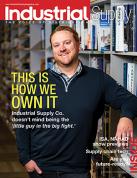Building a World-Class Sales Team
Research reveals the essential skills of top sales teams
by Chally Group
The new economy (post-recession), poses many challenges. One of the most critical is, "Do I have the sales talent on board to execute our business plan and goals?" Sales and customer research conducted by Chally Group Worldwide summarizing more than 35 years of data reveals that "the sales representative, particularly within the distribution business, has become the single biggest factor (39%) in a customer's purchasing decision."
No other factor – the product, its quality or pricing – equals the impact of a salesperson. This can be directly attributed to Six Sigma, lean and TQM methodologies which have minimized / equalized the long-term benefits typically associated with product and pricing. When you couple these findings with information from a recent CSO Insights study, you have a monumental challenge:
- The average tenure for a sales leader during the good times is approximately two years
- Only 53% of sales representatives achieve quotas
- Sales reps win only 49% of their opportunities
- Sales rep turnover averages between 20% to 40%,depending on your industry
This research demonstrates that the steps required to achieve world-class distribution sales status is not easy. It requires focus, discipline and willingness to continuously adapt. Thirty-five years of sales research has identified only 21 companies recognized as "world class" by their customers. It has shown that the winners have transitioned from 100% focused on manufacturing and selling their products to the most recent winners, which were 100% focused on distribution. The explanation for this transition is not complex—successful distributors realize it is not about the product, it is the process and customer experience that differentiates them and provides their only true long-term competitive advantage.
The research found specific requirements needed to achieve world-class sales status.
Company requirements
As demands on salespeople have changed over time, so have the agendas of the sales executives who must invest wisely to ensure that their sales forces are in tune with their customers' needs. Areas identified in the most recent World Class Sales Benchmark winners were:
- Creating a customer-driven culture
- Recruiting / selecting the right sales talent
- Training / developing for the right set of skills
- Segmenting markets in meaningful ways
- Implementing formal sales processes
- Developing enabling information technology
- Integrating other business functions with sales
It is no surprise that creating a customer-driven culture leads the agenda for sales forces considered the best of the best by their customers. As customers' needs have shifted over the years, these companies have remained in sync by uncovering and adapting to the new demands on their salespeople. This focus on customer needs and expectations will never fall from the list, because it is so fundamental to the success of a sales force. Without it, companies become internally focused and tend to impose their own needs on customers, rather than imposing the customers' needs on their salespeople.
One very clear trend in leading sales forces is a dramatically heightened emphasis on recruiting and selection. These companies realize that every other competitive advantage they can achieve in the marketplace (better products, better pricing, better relationships, better technology, etc.) is fleeting. Nearly every other aspect of a business can be duplicated by a competitor except the quality of the people they employ.
As a result, world-class sales forces put more and better effort into finding and hiring the right people for the job. They invest more in the process and cast a wider net. They put in better effort by pursuing more specific skill sets that map into their increasingly complex and specialized selling roles. Across the board, this is an already large and growing concern for sales executives. Major universities now provide minors and majors within sales and, specifically, the University of Nebraska at Kearney has a sales program focused on distribution sales.
Another benchmark that has exploded in prominence is training and development. Getting the raw talent in the office building is a critical accomplishment, but two factors make continued investment in the sales force an imperative. Foremost, top sales forces are now highly complex organizations with processes and technology tailored to their particular selling tasks. A top salesperson from another company cannot simply step into a specialized selling role for another company and be expected to hit the ground running. The "on-boarding" process has grown to a scale never before seen in the sales organization.
The second factor that makes training and development so critical is the rate of change within world-class sales forces. These organizations tend to be nimble and willing to change as soon as the market dictates. With complex internal processes and technology in a constant state of evolution, continuous training is the only way to keep the sales force operating at peak productivity within the organization's business model.
Like customer-driven culture, customer segmentation is fundamental to creating the differentiated customer experiences that lead customers to rave about a sales force. Reviewing the new customer demands like "understand our business," "design the right applications," and "solve our problems," it is easy to see why customer segmentation is so critical for a sales force to succeed in the customer's eyes. Sellers cannot accomplish these objectives with a one-size-fits-all approach to the market, so grouping customers who are alike and aligning sales resources accordingly allows salespeople to develop familiarity with their customers' business issues.
Formal sales processes are the tasks and activities that define how a sales force manages its time, opportunities, customers, territories, salespeople and business. In the past, sales process was almost inextricably mingled with information technology, but the processes are finally standing on their own as sales executives strive for consistency of execution and measurability of performance.
The top sales forces that we observed manage their organization with the discipline of a manufacturing assembly line, with explicit processes that can be benchmarked and improved in the spirit of total quality management. They monitor and measure their salespeople from every possible perspective to isolate best practices and pinpoint opportunities for improvement. They leave little to chance by setting clear objectives for their sales force, providing a road map of how to succeed, and managing their salespeople within this framework of formal sales processes.
Information technology is now a well-entrenched part of any sales force. From CRM to sales force automation (SFA), it is hard to imagine a modern sales force without technology to hold it together. The trend with IT, thankfully, is the recognition that SFA is not a silver bullet that will cure all the ills of a dysfunctional sales force. After the meteoric growth of SFA tools in the 1990s, sales executives are settling down and putting information technology in perspective as an enabler of salespeople, not a reformer.
We observed that sales executives are becoming very skilled at integrating other business functions with sales. Traditionally, sales has been the company function that was least understood and most in its own silo. Sales executives rarely went out of their way to engage IT, HR, marketing and other peer groups in any capacity.
Increasingly, sales executives are finding themselves at the table with these other business functions. They work with IT to build customized technology. They work with HR to hire and develop highly skilled sellers. They work with marketing to equip and inform their salespeople. No longer is sales trying to go it alone in the world.
Salesperson Requirements
Sales executives are aware that customers are now more demanding and want different behaviors from their salespeople. The challenge for executives is to put these demands in the context of their own sales force and create an organization full of people that can meet these new customer needs with the right skills and aptitudes.
Customers expect salespeople to transform themselves into professionals who are exceptional at identifying and satisfying their new buying needs. The following needs, in the customers' own words, are:
1) Be personally accountable for our desired results. Customers are tired of pass-the-buck sellers. They do not want a salesperson to close the deal and run; they want to work with a partner who is personally committed to a successful outcome.
2) Understand our business. For salespeople to personally manage a customer's results, they must deeply understand the customer's business. This means knowing their competencies, strategies, challenges and organizational culture.
3) Be on our side. Buyers expect salespeople to be their internal advocates, manipulating their own company's processes and politics so the customer gets what's needed throughout the
buying process.
4) Design the right applications. Customers want salespeople to think beyond technical features and functions to the implementation of the product or service in the customer's business environment. They want to know not just what the offering will do, they want to know what it will do for them.
5) Be easily accessible. They expect salespeople to be constantly connected and within reach, whenever and wherever needed.
6) Solve our problems. Customers no longer buy products or services; they buy solutions to their business problems. They expect a professional salesperson to diagnose, prescribe and resolve their issues, not just sell them products.
7) Be creative in responding to our needs. When they have a business problem and pursue outside assistance, it is because they perceive their problem as unique and not addressable with conventional solutions. Buyers expect professional salespeople to be innovators who bring them fresh ideas to solve their problems. Creativity is a major source of value in today's salesperson.
In summary, to achieve sales excellence, organizations must implement a process — not an event — and continuously:
- Audit clients to understand their requirements and perception of how well your organization is delivering on their requirements
- Conduct job analysis to identify competencies that predict success in each
sales / customer interfacing role based on client requirements
- Audit your current sales team against these competencies to determine if you have the right talent in the right roles to drive results and customer satisfaction
- Recruit and hire sellers aligned with business and client goals
- Train your salespeople on the skills required by role
- Audit people leaving the role or organization to understand why they left and potential pitfalls
- Continue to adapt to changing client requirements and continue implementing process
For a copy of the full World-Class Sales Research Summary, visit www.chally.com.
This article originally appeared in the Nov./Dec. 2010 issue of Industrial Supply magazine. Copyright 2010, Direct Business Media.













